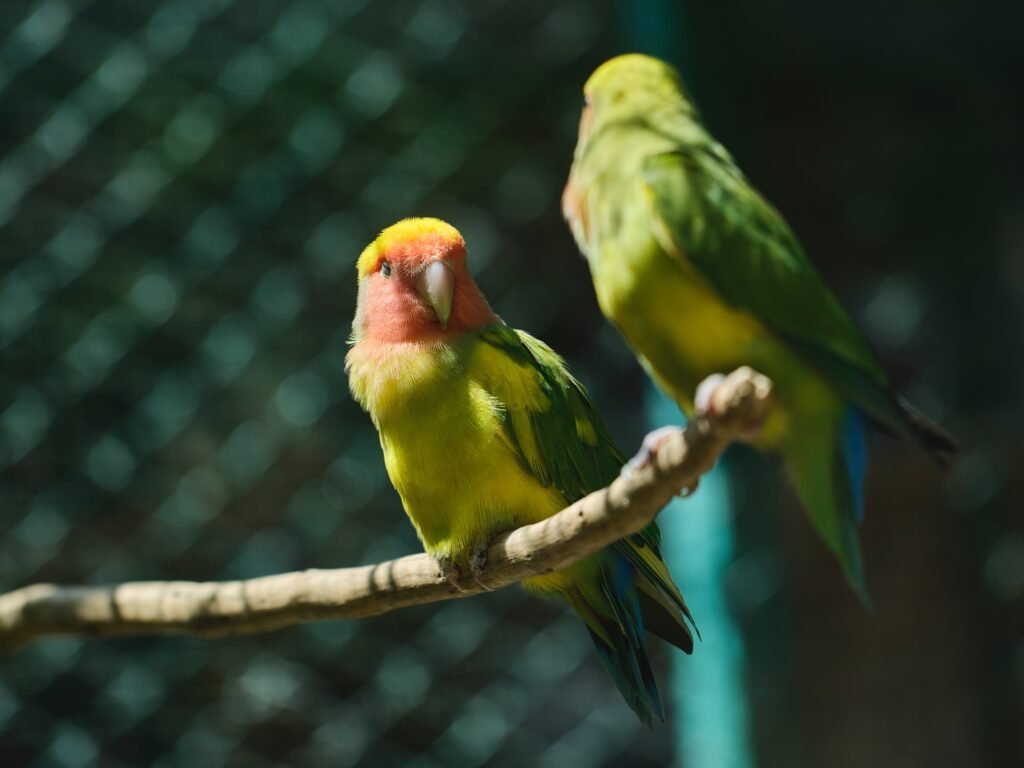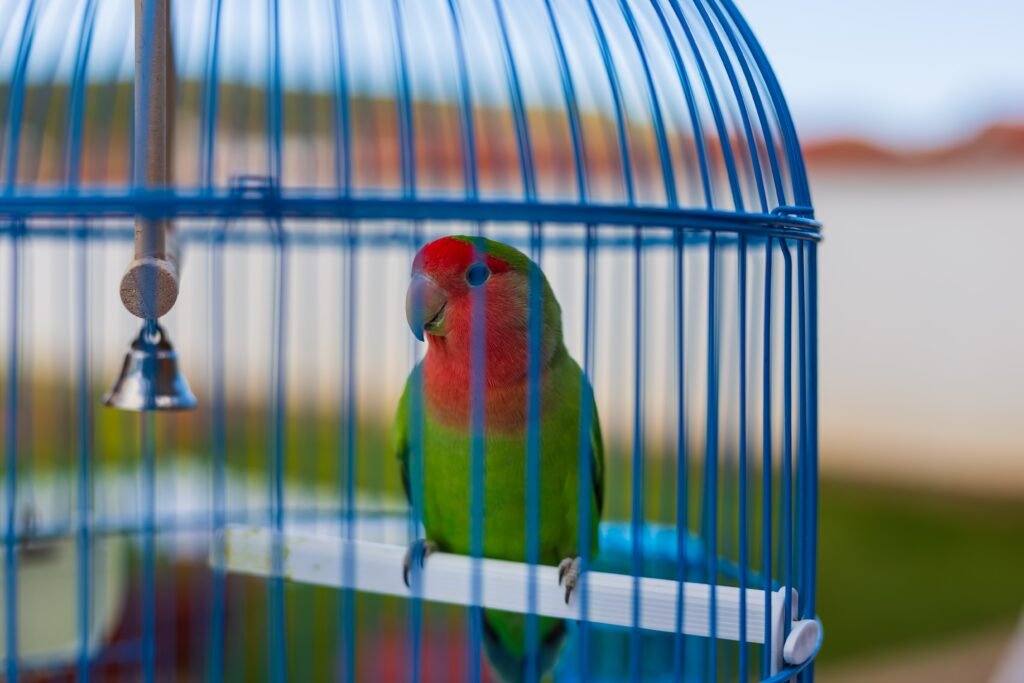Lovebirds, known for their vibrant plumage and affectionate behavior, are visually captivating and possess a fascinating vocal repertoire. These small, intelligent parrots are renowned for their unique vocal abilities, which include a wide range of tunes and calls. In this article, we will explore the various vocalizations of lovebirds and delve into the significance and communication behind these captivating sounds.
Understanding Lovebird Vocalizations
Lovebirds use vocalizations to communicate within their flock and express their emotions. By deciphering their vocal cues, we can gain valuable insights into their social dynamics, mood, and overall well-being. Understanding the different types of vocalizations lovebirds use is essential to effectively interpret their messages.
Contact Calls
Contact calls are the most common form of vocalization among lovebirds. These high-pitched chirps and whistles allow individuals to maintain contact with their mates or flock members. Lovebirds use contact calls to signal their presence, ensure group cohesion, and convey their location.
Contact calls play a crucial role in keeping lovebird flocks together. They serve as a way for individuals to check in with each other and maintain a sense of togetherness. Depending on the distance between flock members, these calls can vary in intensity and pitch. Lovebirds can recognize the unique contact calls of their mates and flock members, allowing them to stay connected even in dense foliage or large aviaries.
Courtship Calls
During courtship rituals, lovebirds produce a melodic and rhythmic series of calls. Male lovebirds often serenade their potential mates with these intricate tunes, showcasing their vocal prowess to attract partners. Courtship calls are an enchanting symphony of trills, warbles, and soft coos, demonstrating the birds’ affection and reinforcing their bond.
Courtship calls serve as a way for lovebirds to communicate their readiness to mate and establish a strong pair bond. These calls are often accompanied by elaborate displays of affection, such as feeding each other or engaging in synchronized movements. The musical nature of courtship calls adds a touch of romance to the lovebirds’ interactions, creating a beautiful spectacle for observers and potential mates.
Alarm Calls
Lovebirds are vigilant creatures who rely on alarm calls to alert their flock members of potential dangers or threats. Loud, sharp screeches or rapid chattering sounds characterize these alarm calls. By emitting these alarm signals, lovebirds effectively communicate the presence of a predator or any perceived threat to their fellow flock members, prompting a coordinated defensive response.
Alarm calls serve as a vital survival mechanism for lovebirds. They allow the entire flock to be aware of potential dangers and take appropriate action to ensure their safety. Lovebirds are highly attentive to the alarm calls of their flock mates, responding quickly and efficiently to the signals. These calls not only help in avoiding predators but also reinforce the strong social bonds within the flock.
Begging Calls
Begging calls are commonly heard from young lovebirds seeking attention, food, or interaction from their parents or older siblings. These calls are often repetitive and carry a distinctive tone of urgency. Begging calls play a crucial role in facilitating the development of social bonds within the flock and strengthening the parent-offspring relationship.
Begging calls are an essential part of the lovebird’s early development. They help the young birds communicate their needs to their parents, who respond by providing food and care. Lovebird chicks learn to trust and rely on their parents through this interaction. Begging calls also encourage the older siblings to participate in the care of the younger ones, fostering a sense of responsibility and cooperation within the flock.
The Melody of Lovebird Tunes
Lovebirds possess a remarkable ability to mimic sounds and even melodies. While each bird has its unique vocal style, some individuals can learn and imitate human speech or mimic tunes from popular songs. This exceptional talent showcases the intelligence and adaptability of these captivating parrots.
Lovebirds are known to incorporate various musical elements into their vocalizations. They often incorporate whistles, trills, and even repetitive melodic patterns into their tunes. Their melodies can be intricate and captivating, leaving anyone who hears them in awe of their musical capabilities.
The ability to mimic sounds and melodies is a form of entertainment for lovebirds and a way to communicate and bond with their human companions. Lovebirds that mimic human speech often enjoy interacting with their owners through vocal exchanges. This talent adds an extra dimension to the already charming nature of lovebirds, making them popular pets for those who appreciate their vocal abilities.
Vocal Variations Across Lovebird Species
There are several species of lovebirds, each with its unique vocal repertoire. Let’s explore the vocal characteristics of some commonly encountered lovebird species:
Peach-faced Lovebirds
Peach-faced lovebirds, scientifically known as Agapornis roseicollis, are renowned for their diverse vocalizations. Their vocal repertoire includes soft coos, chirps, and melodic trills. They often emit loud, high-pitched calls to communicate over long distances, displaying their strong vocal abilities.
Peach-faced lovebirds have various vocalizations to communicate with their flock members. They are known for their ability to produce soft and soothing coos, which are often heard during moments of relaxation and contentment. The melodic trills of these lovebirds add a musical quality to their vocalizations, creating a soothing and enchanting atmosphere in their presence.
Fischer’s Lovebirds
Fischer’s lovebirds (Agapornis fischeri) produce a mix of high-pitched chirping sounds and short, repetitive calls. Their vocalizations often intensify during courtship rituals, with males serenading their potential mates with intricate melodies and rhythmic coos.
Fischer’s lovebirds have a unique vocal style that combines high-pitched chirps with short, repetitive calls. These vocalizations are often heard during excitement or when the birds engage in social interactions. Male Fischer lovebirds showcase their vocal abilities during courtship by producing complex melodies and rhythmic coos to attract a mate. These captivating sounds allow the males to express their affection and establish a strong bond with their potential partners.
Masked Lovebirds
Masked lovebirds (Agapornis personatus) have a distinct vocalization style characterized by soft coos, whistles, and musical calls. Their wide range of vocalizations allows them to communicate effectively within their flock and express their emotions.
Masked lovebirds are known for their versatile vocal repertoire. They can produce soft coos that convey a sense of calm and contentment and whistles and melodious calls that express excitement or playfulness. These vocalizations help masked lovebirds maintain communication within their flock, ensuring the cohesion and social harmony of the group. The diverse vocalizations also allow them to express a wide range of emotions, from affection to curiosity and everything in between.
Nyasa Lovebirds
Nyasa lovebirds (Agapornis lilianae) produce a variety of calls, including soft chirps and trills. They are known for their gentle and melodic vocalizations, which they use to communicate with their mates and flock members.
Nyasa lovebirds have a unique vocal style characterized by soft chirps and melodic trills. These calls are often heard during moments of relaxation or when the birds engage in social interactions. Their vocalizations’ gentle and melodic nature creates a serene and harmonious atmosphere within their flock. Nyasa lovebirds utilize their vocal abilities to express their emotions, maintain social bonds, and ensure the overall well-being of their flock.
Communication and Emotional Significance
Lovebirds use their vocal abilities to communicate and express their emotions. These expressive vocalizations reinforce social bonds, promote courtship, and maintain overall flock harmony. By utilizing a wide range of vocal cues, lovebirds create an intricate language that conveys their feelings and strengthens their relationships.
Lovebirds often engage in vocal duets, where male and female birds alternate their calls perfectly synchronously. These duets are a bonding experience, reinforcing the pair’s connection and enhancing their compatibility. Such vocal harmony is a testament to the lovebirds’ affectionate nature and communication ability through melodious exchanges.
In conclusion, lovebirds possess a vast array of vocalizations that serve as a means of communication, expression, and harmony within their flock. From contact calls to courtship serenades, these intelligent parrots utilize their remarkable vocal abilities to convey messages, express emotions, and strengthen social bonds. The melodious tunes and calls of lovebirds add another layer of fascination to these captivating creatures, making them a delight to both the eyes and ears.
Note: The above article has been generated using AI language models and may not reflect the personal experiences or expertise of a human SEO content writing expert. It is always recommended to consult with professionals in the field for accurate and tailored information.
Lovebirds Vocal Abilities: The Varied Tunes and Calls of Lovebirds
FAQ
1. What are contact calls, and why are they important for lovebirds?
Contact calls are high-pitched chirps and whistles that lovebirds use to maintain contact with their mate or flock members. These calls signal their presence, ensure group cohesion, and convey their location. Contact calls are crucial for keeping lovebird flocks together and allow individuals to check in with each other, even in dense foliage or large aviaries.
2. What are courtship calls, and what purpose do they serve?
Courtship calls are a melodic and rhythmic series of calls produced by lovebirds during courtship rituals. Male lovebirds use these intricate tunes to showcase their vocal prowess and attract partners. Courtship calls communicate the bird’s readiness to mate and help establish a strong pair bond. These calls are often accompanied by displays of affection and add a touch of romance to the lovebirds’ interactions.
3. How do lovebirds use alarm calls?
Lovebirds use alarm calls to alert their flock members of potential dangers or threats. Loud, sharp screeches or rapid chattering sounds characterize these calls. By emitting these alarm signals, lovebirds effectively communicate the presence of a predator or perceived threat, prompting a coordinated defensive response from the flock. Alarm calls help ensure the safety of the entire flock and reinforce social bonds within the group.
4. What is the significance of begging calls in lovebirds?
Begging calls are repetitive, urgent calls commonly heard from young lovebirds seeking attention, food, or interaction from their parents or older siblings. These calls facilitate the development of social bonds within the flock and strengthen the parent-offspring relationship. Begging calls also encourage older siblings to participate in caring for the younger ones, fostering responsibility and cooperation within the flock.
.


